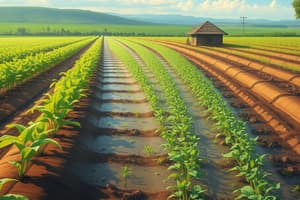Podcast
Questions and Answers
What is one of the benefits of drip irrigation systems compared to other methods?
What is one of the benefits of drip irrigation systems compared to other methods?
- Utilizing large amounts of water resulting in higher crop yields
- Preventing overwatering by delivering water directly to the root zone (correct)
- Causing excessive evaporation by watering the leaves instead of roots
- Requiring manual watering which is time-consuming
Where did the concept of drip irrigation originate from?
Where did the concept of drip irrigation originate from?
- Modern agriculture techniques in the late 20th century
- Ancient civilizations like Egypt, China, and the Andes of Peru (correct)
- World War II innovations in irrigation systems
- Germany in the mid-19th century
What is a notable feature of drip irrigation systems regarding water conservation?
What is a notable feature of drip irrigation systems regarding water conservation?
- Requiring manual monitoring for each plant
- Wasting water through excessive evaporation
- Saving 30-50% of water compared to conventional flood irrigation (correct)
- Being ineffective in delivering water to plant roots
How did modern drip irrigation systems evolve after World War II?
How did modern drip irrigation systems evolve after World War II?
What is a significant advantage of installing and maintaining drip irrigation systems?
What is a significant advantage of installing and maintaining drip irrigation systems?
What is one benefit of drip irrigation in terms of system maintenance?
What is one benefit of drip irrigation in terms of system maintenance?
How does drip irrigation contribute to improved plant performance?
How does drip irrigation contribute to improved plant performance?
What component ensures controlled amounts of water are delivered to plant roots in a drip irrigation system?
What component ensures controlled amounts of water are delivered to plant roots in a drip irrigation system?
How does drip irrigation contribute to cost savings for farmers and gardeners?
How does drip irrigation contribute to cost savings for farmers and gardeners?
In what ways can drip irrigation systems be adapted according to the text?
In what ways can drip irrigation systems be adapted according to the text?
Flashcards are hidden until you start studying
Study Notes
Introduction
Irrigation is an essential aspect of modern agriculture, enabling the growth and survival of many crops in diverse climates. Over centuries, various methods of irrigation have evolved from traditional techniques to sophisticated engineering innovations. One of these advancements is drip irrigation, which offers numerous benefits compared to conventional flooding and sprinkler systems.
Origins of Drip Irrigation
The concept of drip irrigation can be traced back to ancient civilizations such as Egypt, China, and the Andes of Peru, where methods like buried porous clay pots were used to distribute water through capillary action. However, it was not until the mid-19th century that the first modern drip irrigation systems emerged in Germany, utilizing clay pipes for drainage and later shifting towards plastic materials following World War II.
Benefits of Drip Irrigation Systems
Water Conservation
Drip irrigation is more efficient than other methods due to its ability to place water directly into the root zone, preventing overwatering and reducing evaporation. Research indicates that micro-irrigation techniques such as drip irrigation save up to 30-50% of the water required compared to conventional flood irrigation.
Time Savings
Installing and maintaining drip irrigation systems eliminates the need for manual watering, saving hours of labor and allowing for automation via timer controls. Additionally, system maintenance is less frequent when compared to traditional irrigation methods.
Versatility
Drip irrigation can be adapted to various terrains and plant types, including row crops, greenhouses, vineyards, urban landscapes, and hillsides. Furthermore, it is suitable for both commercial operations and home gardens, making it a versatile choice for diverse applications.
Improved Plant Performance
By delivering water directly to the plants' roots, drip irrigation maintains optimal moisture levels, promoting improved plant productivity and quality. It also minimizes contact between leaves and stems with water droplets, reducing the risk of disease caused by excessive wetness.
Efficiency and Cost Savings
The precision of drip irrigation leads to lower water usage overall, translating into cost savings for farmers and gardeners alike. Its efficiency also reduces the requirement for additional fertilizers and other nutrients, further contributing to economic benefits.
Components of Drip Irrigation Systems
A typical drip irrigation system consists of several components, including mainlines, valves, sub-mains, backflow preventers, pressure regulators, filters, tubing adapters, drip tubing, emitters, and end caps. These parts work together to deliver controlled amounts of water to the roots of plants while ensuring proper water flow management and filtration.
Conclusion
Modern drip irrigation systems have revolutionized agriculture and gardening practices around the world. By offering increased efficiency, conservation, flexibility, and improved crop health, drip irrigation is poised to continue shaping sustainable agricultural practices across diverse geographies and climates.
Studying That Suits You
Use AI to generate personalized quizzes and flashcards to suit your learning preferences.




